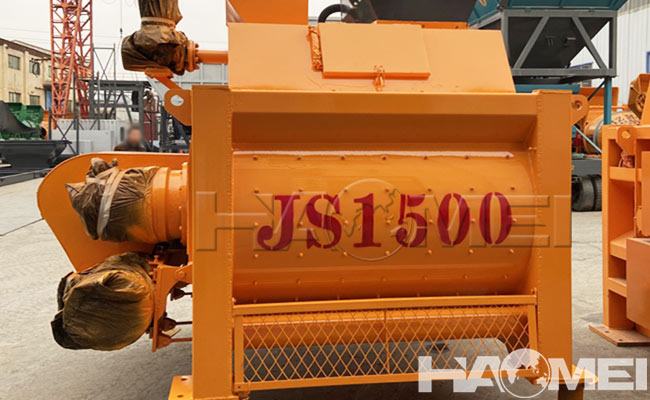Concrete Mixer Machine Capacity In Cubic Meter
JS concrete mixers are commonly used forced mixing equipment in engineering construction. The concrete mixer machine capacity is standardized by their rated discharge capacity (the volume of concrete produced in a single batch), measured in cubic meters (m³).
Concrete mixer capacities vary depending on their design and intended use. Common capacity ranges include:
Small concrete mixers: typically between 0.5 and 1 cubic meter, suitable for small projects or home use.
Medium concrete mixers: generally between 1 and 2 cubic meters, suitable for medium-sized construction projects.
Large concrete mixers: typically between 2 and 4 cubic meters or larger, suitable for large-scale construction projects and industrial applications.

JS series concrete mixers cover small to large-scale engineering needs. Common models and capacities are as follows:
Model | Rated Discharge Capacity | Rated Feed Capacity | Applicable Scenarios
JS500 | 0.5m³ | 0.8m³ | Small precast component factories, rural self-built houses
JS750 | 0.75m³ | 1.2m³ | Township road construction, small building construction
JS1000 | 1.0m³ | 1.6m³ | Medium-sized engineering sites (e.g., commercial buildings)
JS1500 | 1.5m³ | 2.4m³ | Commercial concrete mixing plant
JS2000 | 2.0m³ | 3.2m³ | Large-scale projects (e.g., bridges, high-rise buildings)
JS3000 | 3.0m³ | 4.8m³ | National key projects (e.g., high-speed railways, hydropower stations)
JS4000 | 4.0m³ | 6.4m³ Large-scale projects (e.g., large-scale infrastructure)
Core basis for concrete mixer machine capacity selection:
- Project scale
Small projects (e.g., rural self-built houses): Choose JS500 or JS750, with a single output of 0.5-0.75 m³, meeting low-output requirements.
Medium-sized projects (e.g., commercial buildings): JS1000 is the mainstream choice, with a single output of 1 m³, balancing efficiency and cost.
Large projects (e.g., bridges, high-speed railways): Require JS1500 or higher models, with a single output of 1.5-4 m³, ensuring continuous and efficient construction.
- Production efficiency requirements
The theoretical productivity (m³/h) of the concrete mixer is directly proportional to its capacity. For example:
JS1000: Theoretical productivity ≥ 50 m³/h (calculated based on 60 seconds/cycle).
JS3000: Theoretical productivity ≥ 150 m³/h (calculated based on 60 seconds/cycle).
Actual productivity needs to be comprehensively evaluated considering factors such as mixing cycle and equipment maintenance.
- Equipment Compatibility
The concrete mixer needs to be compatible with equipment such as batching machines and conveyor belts. For example: The JS1000 is often paired with a PLD1600 batching machine to form a small concrete mixing plant.
The JS3000 requires a PLD4800 batching machine to meet the needs of large-scale projects.
The larger the concrete mixer capacity, the higher the required motor power to ensure sufficient mixing power. The mainstream motor power is as follows:
Model | Motor Power | Mixing Blade Speed (r/min)
JS500 | 18.5kW | 35
JS750 | 30kW | 30.5
JS1000 | 37kW | 25.5
JS1500 | 75kW | 25.5
JS2000 | 74kW | 25.5
JS3000 | 90kW (or 2×55kW) | 28
The larger the concrete mixer capacity, the larger the aggregate size it can handle, to meet the needs of concrete of different strengths:
Model | Maximum Aggregate Size (pebbles/crushed stone)
JS500 | 60mm/40mm
JS750 | 60mm/40mm
JS1000 | 60mm/40mm
JS1500 | 80mm/60mm
JS2000 | 80mm/60mm
JS3000 80mm/60mm
The larger the concrete mixer machine capacity, the larger the equipment size (length × width × height) and weight, requiring sufficient installation space:
Model |Transport Dimensions (mm) |Working Dimensions (mm) |Total Weight (kg)
JS1000 | 4195×2300×2800 | 5980×2300×6260 | 8750
JS3000 | 6760×2450×2890 | 12580×4620×12890 | 20000
Selection recommendations
Small Projects: Prioritize JS500 or JS750 for lower cost and smaller footprint.
Medium Projects: JS1000 offers the best value, balancing efficiency and flexibility.
Large-scale projects: JS1500 and higher models can meet high-output requirements, but require a complete batching plant system.
Special requirements: For mixing dry-hard concrete, models with lower blade speeds and higher torque (such as JS3000) should be selected.

